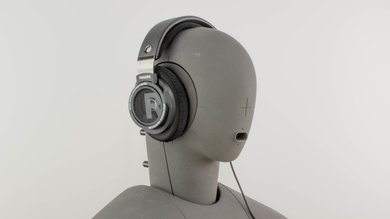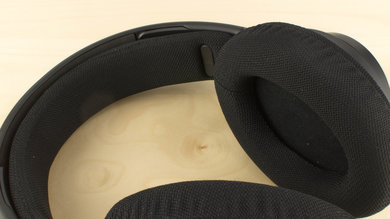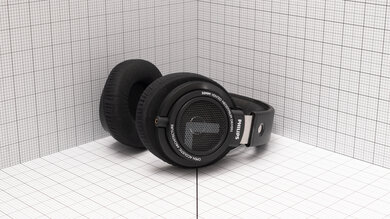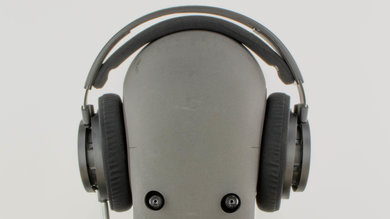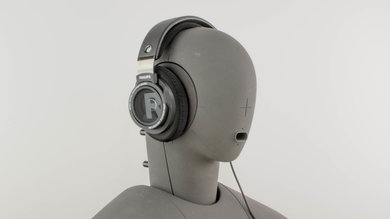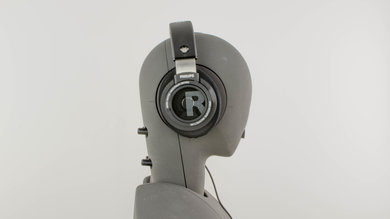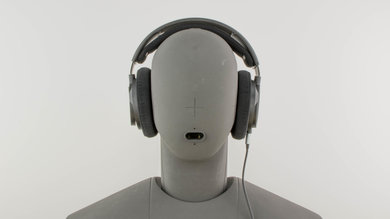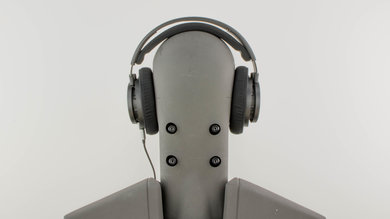The Philips SHP9500 are entry-level audiophile headphones. They're a great gateway into the world of open-back, audiophile headphones, given their accessible price and angled neodymium drivers. They also have a low impedance of 32 ohms with a sensitivity of 111.9dB SPL, so you can get away without using them paired with an amp if you don't already have one.
Our Verdict
The Philips SHP9500 aren't suitable for sports and fitness. They're audiophile headphones, and their bulky, wired design can easily shift in position and fall off while you're moving. Their cable can also snag on something and yank them off your head. On the upside, their audio cable is detachable.
- Comfortable design.
No amp or DAC required to drive them.
- Bulky and not very stable fit.
Don't block out background noise at all, by design.
- Leak audio, by design.
The Philips SHP 9500 aren't designed with travel in mind. They're bulky and don't block out background noise due to their open-back design, so you'll hear all the low rumbles of bus engines and people talking around you. They also leak audio, so even if you listen to audio at low volumes, others around you can hear it. That said, these cans have a very comfortable fit.
- Comfortable design.
No amp or DAC required to drive them.
- Bulky and not very stable fit.
Don't block out background noise at all, by design.
- Leak audio, by design.
The Philips SHP9500 aren't the best choice for office use. They have an open-back design, which doesn't block out background noise, and leaks a lot of audio, even at moderate volumes. Since they're audiophile headphones, they also lack a mic, so you can't take calls or online meetings with them. On the upside, they have a very comfortable fit suitable for long days at your desk.
- Comfortable design.
No amp or DAC required to drive them.
- Bulky and not very stable fit.
Don't block out background noise at all, by design.
- Leak audio, by design.
The Philips SHP9500 are wired headphones; you can't use them wirelessly.
The Philips SHP9500 are alright for gaming, so long as you have a standalone mic or don't need a mic at all. While their sound is light on bass, which can make explosions less impactful, they produce dialogue clearly, and soundtracks come across as natural-sounding. Their open-back design also creates an immersive listening experience, as if the sound is coming from around you in the room. Because of their lightweight design, they feel comfortable to wear for long periods without feeling fatigued.
- Comfortable design.
- Deliver audio consistently.
No amp or DAC required to drive them.
- Bulky and not very stable fit.
Don't block out background noise at all, by design.
- Leak audio, by design.
The Philips SHP9500 are a good choice for audio reproduction accuracy. Their frequency response follows their flat sound profile well, with only a few peaks and dips in the treble range. While their group delay isn't the best, it mostly impacts bass-range frequencies that aren't properly reproduced by the headphones anyway. Otherwise, these headphones exhibit good driver matching, with no audible distortion or coloration in audio reproduction. While the PRTF response is quite different from that of an angled reference speaker, they're still capable of creating an impression of space and distance.
The Philips SHP9500 have terrible noise isolation, but this is by design, given they're open-back headphones. You'll hear pretty much everything in your surrounding environment, regardless of the frequency range in which these noises fall.
The Philips SHP9500 don't have an integrated microphone, so you'll need to purchase a standalone mic if you need mic capabilities.
The Philips SHP9500 have good frequency response consistency. While there are some minor deviations in the bass and treble range between different reseats and varying facial characteristics, you can minimize their impact by taking the time to ensure a solid fit.
Performance Usages
Changelog
-
Updated Aug 08, 2025:
We've updated this review's introduction to reflect the correct sensitivity measurement of 111.9dB SPL.
-
Updated Jul 29, 2025:
We've updated the Sound Profile box with a link to a downloadable folder of EQ settings that will help you match these headphones' frequency response to different target curves available in our Graph Tool.
-
Updated Jul 14, 2025:
This review has been updated to Test Bench 2.0, which adds the following tests: Stereo Mismatch, Group Delay, Cumulative Spectral Decay, PRTF, Harmonic Distortion, and Electrical Aspects. We've added new performance usages and updated the text throughout the Sound tests and side-by-sides.
- Updated Jul 10, 2025: We've converted this review to Test Bench 2.0, which updates our sound tests and adds performance usages. You can read more about this in our changelog.
Check Price
Differences Between Sizes And Variants
The Philips SHP9500 come in one color variation: Black. If you encounter another variant of these headphones, please let us know in the comments, and we'll update our review.
Popular Headphones Comparisons
The Philips SHP9500 are wallet-friendly open-back headphones. If you want to get into the audiophile sphere, these cans are a good start, thanks to their flat and neutral sound. Their design allows audio to leave the ear cups and interact with your environment, creating a solid impression of space and distance. They lack a thumpy low bass, which is often the trade-off with open-backs compared to closed-back headphones, like the Audio-Technica ATH-M50x.
Check out our recommendations for the best wired headphones, the best audiophile headphones, and the best open-back headphones.
The Philips SHP9600 are very similar performing open-back headphones to the Philips SHP9500. The SHP9600 have a sleeker, all-black design and leak less audio. Both headphones have very balanced sound profiles that suit a wide range of music genres, though the SHP9500 comply most closely with our target curve with a flatter bass. For greater boom on the bass, the SHP9600 tend to provide more punch on kicks.
The Sennheiser HD 560S and the Philips SHP9500 have different strengths, and you may prefer either. Both models are great open-back headphones for their open and spacious listening experiences, but the Sennheiser are more stable to wear. On the other hand, the Philips are a bit more comfortable, so they can feel less fatiguing to wear for long listening sessions.
The Philips SHP9500 and the Philips Fidelio X2HR are both great open-back headphones for neutral sound listening. The Fidelio X2HR have a sleeker and more premium design, and they look and feel a bit more durable. Their bass range also provides more punch. While the X2HR have an auto-adjusting headband, the SHP9500 are a little bit more comfortable overall, as they don't clamp the head as tightly, and their treble range is a bit more even, but this can depend on your preferences. Both perform very similarly, but the SHP9500 likely represent better value overall.
The Philips SHP9500 and the Sennheiser HD 599 are very comfortable headphones that are great for neutral listening. The Sennheiser are a bit sleeker and a bit more stable to wear. They're also more consistent in their audio delivery. Depending on your tastes, you may prefer the brighter voicing of the Philips compared to the mid-rangey Sennheiser sound profile. The Philips also have a more open and spacious sound.
Test Results

These headphones have a flat sound signature that rolls off the bass range, while maintaining clarity and detail in the mid and treble ranges.
We've created a downloadable folder of EQ settings you can use to align these headphones with some of the target curves in our graphing tool.
The frequency response consistency is good. They're prone to slight inconsistencies in treble and bass delivery due to positioning and fit. However, once you take the time to ensure a good fit, you'll get consistent audio delivery each time you use them, regardless of your facial characteristics.
Their bass profile's target compliance is passable. They lack a lot of low bass, which is normal from open-back headphones, so mixes are light on thump and rumble. However, their high bass matches our curve well, adding warmth and boom to kick drums without overwhelming vocals and instruments.
These cans have an outstanding mid-range target compliance. The range is very even, ensuring that vocals and instruments sound natural and clear in mixes. In songs like Pruitt Igoe by Philip Glass, the cascading strings and piano halfway into the track are smooth and accurate.
These over-ears have excellent treble target compliance. The mid-treble is slightly over-emphasized, adding a touch of sharpness to sibilant sounds (S and T). Besides a couple of small dips, the rest of the range is relatively smooth, with little noticeable harshness that can impact your listening experience.
The peaks and dips performance is good, which indicates the headphones control their sound profile well. The low bass is very balanced, with little deviation from the over sound profile. Similarly, the mid-range is very even for a balanced voicing. A small dip where the high-mids transition to the low-treble hurts the intelligibility of vocals a touch. The rest of the low treble is a bit over-emphasized, adding extra brightness to vocals. The headphones' slightly uneven mid-treble can make sibilants like cymbals alternatingly piercing or slightly dulled.
The stereo mismatch performance is good, indicating that these headphones' L/R drivers have tight tolerances. While there are minor fluctuations in amplitude between the left and right channels across the frequency range, they're not noticeable with everyday audio content. Similarly, while there's a peak in the phase response in the high-treble, it happens in a range that we lose sensitivity to over time, so it won't be noticeable.
The Philips SHP9500 have an okay group delay performance. There are some peaks in the group delay in the low-bass region that are unlikely to translate to loose bass notes, as the headphones' frequency response doesn't extend that low anyway. Group delay is low across the rest of the frequency range, though, resulting in transparent audio reproduction.
The Philips SHP9500 are able to create a decent perception of distance and space in your audio. While their PRTF response differs quite a bit from that of an angled loudspeaker, they're still able to add an immersive quality to recordings or video games.
The harmonic distortion performance is great. While distortion is somewhat elevated in the bass range at both regular and loud listening levels, our ears aren't very sensitive to audio coloration in this band and distortion is low across the rest of the frequency range. As a result, audio reproduction is clean and pure regardless of the volume you listen to music at.
You won't need an amp or DAC to drive these headphones—they're capable of reaching high listening levels while connected to mobile end devices, like phones or laptops.
These are the settings used to test these headphones. Our results are only valid when used in this configuration.
The Philips SHP9500 have a utilitarian design that looks good without being too flashy. They come in a matte black color scheme highlighted by the metal frame and Philips branding on the ear cups and headband. They're well-padded and look more premium than other headphones above their price range. The ear cup padding is soft. However, it's not the best and looks a little cheaper than the rest of the build quality. For headphones with a slightly sleeker look, see the Philips SHP9600.
These over-ears are very comfortable. They have large ear cups that easily fit around most sizes of ears, and their fit isn't too tight or heavy on the head. The headband and ear cups are well-padded, making them great for long listening sessions. However, the padding is made from a slightly rough fabric, which can irritate the skin.
These headphones aren't designed to be portable. They're quite large and don't fold into a more compact format. The ear cups also don't lay flat to save space, so they're bulky if you want to put them into a backpack. However, this won't be much of a problem since they're intended for use at your desk.
These headphones are decently well-built. They're mostly made of plastic with a thin metal headband to help reinforce their frame. However, the fabric padding seems to tear easily and will show wear faster than leather padding. The swiveling ear cups also feel like a weak point since they can break under moderate stress. If you want something that looks and feels a bit more premium and durable, check out the similarly-performing Philips Fidelio X2HR or the Philips Fidelio X3.
These headphones have a fairly stable fit. They'll stay in place if you're listening to audio at your desk. However, they're still big and bulky, so if you move your head a lot, the headphones can easily slip off your head. Luckily, the audio cable is detachable, so it'll disconnect from the headphones if you accidentally hook them on something.
The Philips SHP9500 aren't designed to block out background noise. Their open-back design allows the environment's ambient sound to mix with your audio, helping to create a more immersive audio experience. They slightly block very high frequencies. If you're looking for audiophile headphones that block background noise, check out closed-back headphones, like the Sony MDR-7506 instead.
As expected of open-back headphones, these have terrible noise isolation in common scenarios. You're best off using them in quiet spaces because environmental sounds like people chatting and the general racket associated with transportation will all reach your ears virtually unaffected.
These headphones have an open-back design meant to leak audio so sound can interact with your environment and create a more immersive sound. As a result, people around you can hear your audio, even at moderate volume.
These headphones come with a long, detachable 1/8" TRS cable and a 1/8" to 1/4" adapter so you can connect them to standard-sized headphone outputs. Thanks to their low impedance and somewhat high sensitivity, you can also use them without an amp, and because these are analog headphones, their latency is imperceptible.
You can connect these headphones to your PC via analog, but you can only receive audio since they don't have a mic.
You can plug their analog cable into your PlayStation console's AUX port for audio support. However, they're audiophile headphones and don't have a mic.
You can plug these headphones into your Xbox controller's AUX port and receive audio. Since they don't have a mic, you can't chat with others.


